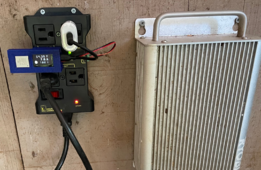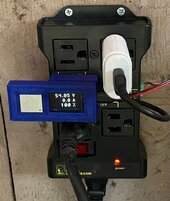*REVISED*
I'm still struggling a bit with the whole pre-charge circuit thing. I took the side cover off the mower to access where the primary contactor is located.
I have read a lot of information in regards to pre-charge circuits using contactors and such for EV vehicles which use much higher voltage battery packs and capacitors, but technically the problem still exists for these Ryobi mowers which is why my battery BMS seems to trip due to the inrush current when the motor capacitors have drained.
It seems to be fairly straightforward to install a 48v rated DC momentary switch with a resistor across the existing solenoid/contactor, hold down the momentary switch for a period of time, then turn the mower key switch to 'ON' to activate the contactor. While that appears to be a simple approach, I didn't like the idea of requiring a procedure to pre-charge the mower. Also, there is nothing to prevent someone from forgetting a step and just turning the mower key on without holding the "pre-charge" momentary switch resulting in tripping the BMS. I have been trying to figure out a more elegant solution.
I wanted to stick with the existing mower single key to turn the mower on without the need to remember to pre-charge. After doing some research it looks like a Single Pull Double Throw (SPDT) multi-function timer relay would do the trick for the timing part. If I set the timing option to a non-signaled ON-DELAY where the default switch path directed to the pre-charge circuit.
The idea is that while the mower key is in the OFF position nothing runs since the entire mower circuit is open. The SPDT timer relay is in the default position that would by default send its current through a pre-charge circuit which is just the resistor connected to the output side of the contactor. When you turn the starter key to the ON position it would close the main circuit while using the switch path for the pre-charge circuit. After a configurable time (say 5-10 seconds) the timer relay would energize and automatically switch to the activate the primary current path through the contactor. When you turn the mower key off it resets everything back to the default state.
The only caveat is that you would need to remember that there is a x-second delay until the current is switched over to the primary contactor from the timer relay. I'm thinking of adding a couple of small LED lights, one to each switch path from the timer relay, where the led light is RED when the pre-charge circuit is active and then it will turn off and activate a GREEN led on the main contactor path when the timer relay switches to the that circuit path.
I was also considering moving the battery meter/shunt Bpos wire from the battery terminal, which always causes the meter to be on, to the outbound connector of the contactor so that the monitor would only turn on only when the mower is turned on and avoid the trickle drain on the battery.
When I originally posted I was trying to avoid another switch beyond just using the timer relay plus resistor as the path for the pre-charge circuit. However, I got concerned that the timer relay coil contact switch wasn't actually rated for 48v. So I decided it was probably safer to just get another 48v ClubCar solenoid/contactor that is rated for 48v DC with an additional resistor to use for the precharge circuit. Then I adjusted the wiring for the timer relay from using the wires from the 48v switch to hooking onto the 12v wires that are used to signal the primary contactor/solenoid. It seemed to be the safest approach and keeping everything within the DC voltage specs of each component. It also allows you to just use the key to turn on the mower without any other steps than waiting a few seconds for the pre-charge to complete automatically.
I updated my original pre-charge circuit design to the attached image. I would be curious what the group thinks about this approach.
I figured worse case it doesn't work, I pick up a 48v DC momentary switch and just install that which would be the most simple. I was also struggling a bit with how to mount another contactor/solenoid for the pre-charge, the timer relay, and the pre-charge resistor. My working theory is to use an 8" slotted stainless steel mender "sandwiched" between the original contactor and its mounting bracket. Then I can mount the pre-charge solenoid to the extended part of that mender. The slots give me flexibility to shift things around. I'm thinking of using a few other strips of the slotted menders to act as "hangers" off the horizontal mender so that I can mount the timer relay and pre-charge resistor below the pre-charge solenoid/contactor. This should give me some flexibility to shift things around without trying to fabricate a mounting plate of some kind.
I'm going to try to test this out when I get all the parts in this week. If it works, I'll post final pictures.






